Transylvania after 1989: Heritage and Diversity management in a Multicultural society
 In 2007, the Transylvanian city of Sibiu was selected together with Luxembourg to be the European Capital of Culture. Sibiu’s rise to prominence and revitalization stimulated cities that shared the same multicultural profile; an increasing number of them drew their own development strategies, placing culture as central asset for economic growth and urban regeneration. While local strategies still depend on governmental directives, these cities turned themselves into a vanguard reshaping planning processes in Romania, changing to the concept of local and regional governance with the substantial inclusion of private organizations, associations, the business milieus and other local communities. Transylvania appears today as a secretive space in Europe, pour les connaisseurs, a place untold where exceptional experiences can happen, where tourism focuses on quality local lifestyle, ecology and gastronomy; Dracula, longtime undesirable, proved useful in drawing tourist attention by creating the opportunity to educate visitors with regard to the region’s history.
In 2007, the Transylvanian city of Sibiu was selected together with Luxembourg to be the European Capital of Culture. Sibiu’s rise to prominence and revitalization stimulated cities that shared the same multicultural profile; an increasing number of them drew their own development strategies, placing culture as central asset for economic growth and urban regeneration. While local strategies still depend on governmental directives, these cities turned themselves into a vanguard reshaping planning processes in Romania, changing to the concept of local and regional governance with the substantial inclusion of private organizations, associations, the business milieus and other local communities. Transylvania appears today as a secretive space in Europe, pour les connaisseurs, a place untold where exceptional experiences can happen, where tourism focuses on quality local lifestyle, ecology and gastronomy; Dracula, longtime undesirable, proved useful in drawing tourist attention by creating the opportunity to educate visitors with regard to the region’s history.
Historical Context and Adjustment of Cultural Policies
As Communism was left behind – with the ideological culture it produced in half a century –, producing a new decision-making process that targeted doctrine conformity and radical nationalism was not an easy task, and certainly not something that the Romanian governments after 1989 were ready to do and maybe not even eager, except for the Democratic Convention of 1996-2000. In terms of values, Romania adopted cultural policies based on four identified reasons. The first is the national interest, the self-esteem and the international standing, built on identity, history and patrimony, emphasizing national identity through events destined to celebrate the country image, running the risk of being bureaucratically unproductive and with diplomatic limitations. The second emphasized the economic growth and the social cohesion that culture brought, in an attempt to maximize the European credentials of the country; this approach would have theoretically improved the understanding of culture, but, as a cultural private market did not exist at the time, nor private support for culture, the public intervention in this sphere remained crucial, even if it distorted cultural projects, the art world or creativity itself because of the need to comply with administrative requirements. As for the third reason – culture as factor of quality life –, the expectations were never met: traditional, canonical forms were favored over nontraditional or alternative, with a complete neglect of stakeholders from other social sectors. National-oriented or not, Romania had to diversify the forms of cultural expression, the related activities, the actors involved, and to assimilate the transformations generated by ever-progressing cultural industries.
After 2007, the Romanian government generated cultural strategies destined to bring closer the policies of cultural development (heritage protection included) to those of the European partners. Despite bureaucratic inflation, attention was however dedicated to a strategic development of culture, defined as “factor of social improvement”, “an instrument for the accomplishment of social and economic objectives”, and were accompanied by analyses and evaluations, strategic objectives, priorities; they suggested directions of action or intervention, strategy implementation, planning and financing instructions, and brought numerous recommendations. The situation changed in time, without necessarily evolving. The 2005 National Development Plan for 2007-2013 focused on six development priorities: economic competitiveness through knowledge-based economy; modernization of transport infrastructure; protection and quality improvement of the environment; development of human resources, employment and social inclusion, with strengthening the administrative capacity; developing rural economy and increasing productivity in the farming sector; as well as diminishing development disparities between country regions. The priorities’ list did not include culture, only tangentially named as a “source for tourism development as well as for the growth potential and regeneration of urban centers”.
Romania additionally subscribed to the European Agenda for Culture in a Globalizing World, whose priorities were: the promotion of cultural diversity and intercultural dialogue; of culture as a catalyst for creativity and innovation in the context of the Lisbon Treaty (stimulating cultural industries and economy); and reinforcing the cultural dimension as a vital element of EU external relations. The position papers of the government reflected the new approach of national development planning, where culture was integrated as a component of sustainable development. It was included as such in the Governmental Program of 2009-2012, the Governmental Program of 2013-2016 and in the National Development Strategy for 2013-2020-2030. The national objective was to set up and maintain a “coherent legislative, regulatory and institutional framework for the cultural domain”, harmonized with existing EU regulations and practices; to implement the first steps of the action plan “for the listing, preservation and promotion of the national cultural heritage and contemporary cultural assets, and for closer links with the European and universal space of cultural values”; to “enhance access of all categories of people from all regions and social environments to information and culture, and to improve the social and economic condition of artists”. The institution responsible for the development of the cultural strategies and policies adopted, the Ministry of Culture and National Patrimony, set objectives that follow the national strategy : “safeguarding the national cultural patrimony and the maintenance of the cultural heritage and diversity”, “increasing the number of participants to culture and cultural events”, “the modernization and internationalization of the cultural infrastructure and the professionalization of the human resources within”, “support for contemporary art and creative industries”, next to research in cultural policies, promotion of “national values on international level” (via a Romanian Cultural Institute), and promotion of multiculturalism and minorities’ cultures.
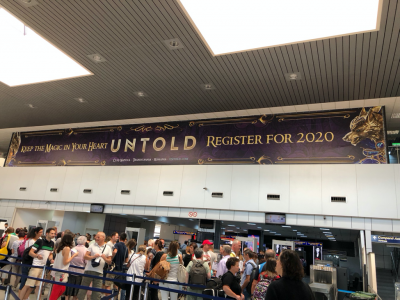
The airport of Cluj-Napoca, capital of Transylvania. © R. Belot
This line of action indicates that the Romanian perspective on the development of culture and of the cultural policies was to be oriented towards (1) national heritage, (2) more public involvement in culture, and (3) development of creative industries. Five State-financed sub-programs were envisaged in a supplementary document of the Ministry of Culture and National Patrimony, dedicated to the public policies, strategy and structural policy coordination for Culture (2009), aiming at the protection and the safeguarding of the national cultural patrimony (historical and archeological monuments, museums and collections, immaterial patrimony), the promotion of contemporary creation and of cultural diversity, the development of multilateral international relations for the promotion of Romanian culture abroad (and promoting foreign cultures at home), support for the cultural institutions subordinated to the Ministry, rehabilitation of historical monuments, and modernization of public cultural institutions.
This ambitious design was completed by a document with a cultural strategy for 2014-2020, The Sectoral Strategy for Culture and National Patrimony 2014-2020 (produced by the Ministry of Culture in 2013), shadowed by a similar one issued for 2016-2022. Both tend to underline a certain transition towards a new understanding of culture. Two types of objectives are settled, with short-, middle- and long-term plans to be carried out by various institutions: the Romanian Government via the Ministry of Culture, the Romanian Parliament, the regional and local administration, and, complementarily, the Ministry for Development, the Ministry of Public Finances, NGOs, etc. Objectives include “the protection of national cultural heritage” (whose definition remains unchanged as “immobile patrimony, mobile cultural patrimony and immaterial cultural patrimony”), next to the support and promotion of contemporary cultural and artistic creation; supplementary purposes concern education, cultural intervention, institutional capacity, the cultural infrastructure, and the four transversal objectives to be implemented “the participation and involvement of young people in cultural activities”, the “digitization of the cultural resources”, the “enhancement and diversification of cultural offer”, and accordingly “cultural consumption”, “the exportation of national cultural products” and the “internationalization of culture”. This strategy continues the objectives previously settled with regard to national patrimony and cultural heritage; yet it opens up towards new lines of action stressing on the economic advantages of culture, and the economic growth that culture can generate.
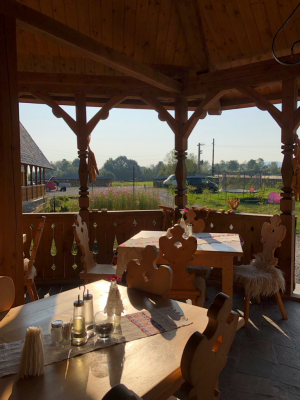
An inn for tourists in Transylvania reconstructed on the bottom of an imaginary heritage model. © R. Belot
By adopting European prototypes of cultural strategy, this interpretation of culture constitutes a new approach for Romania’s governmental policies; it aims trans-sectoral dynamics and values culture as catalyst for local, regional and national economic and social development. In addition, there is a sense of transition towards a more decentralized approach; new angles of cultural policies are now being explored by national institutions and local authorities. Yet, this bureaucratically manicured practice of culture and heritage has a limited impact because of the number of monuments (designated as such and included on the lists of the Ministry of Culture by the Institute of National Patrimony) in need for restauration or renovation, putting pressure on the capacity of the State to face demands of financial assistance; and because of the scarcity of qualified personnel capable of implementing specific policies with regard to local or regional patrimony.
But still… The word “decentralized” demonstrates a change in mindset, something that modified the government’s logic and technique in managing culture and heritage in a time span of less than 10 years. The origins of it are to be found outside Romania – and the promoters, inside.
“A Prince on a White Horse”
It was indeed under the impact of annual visits of the Prince of Wales in Transylvania (the central-western, multicultural province of Romania), that local actors such as NGOs and foundations started to play a more visible role in the cultural management of assets considered to be part of a (certain) heritage. Transylvania (Siebenbürgen for the Germans, Erdély for the Hungarians) is a typical case of intertwined, complementary destinies, where ethnicity and politics created separate legitimacies, backing claims fundamentally opposed if taken individually, coherent if treated as a whole. Longtime politically Hungarian, thus Catholic and Protestant, Transylvania was ethnically Romanian (and Orthodox), given the vast majority of the population living in rural areas, with Germans settled as colonists in the 13th century, themselves Catholic and later Protestant. It was this ethnic triptych, next to the geographic location, that defines Transylvania as a triplex confinium, triple neighborhood. As Nationalism rose in the 19th century, the political divide between the Hungarian and Romanian communities deepened, with colliding historiographies and opposing arguments, up to the point of military conflict in the two World Wars. Incorporated to Romania in 1918-1920, with 1.2 million Hungarians living today in the area, Transylvania became the focal point of a Romanian-Hungarian antagonism similar to the Irish-English, Serbian-Albanian or French-German discords. It was in this culturally and politically unsettled climate that the visits of the Prince of Wales – himself of Hungarian and Romanian descent – took place since 1998, as the heir to the British Crown showed interest for the landscape, the local customs, the traditional architecture and the region’s cultural heritage, material and immaterial. These visits were the natural consequence of more than a decade of defending Transylvanian heritage.
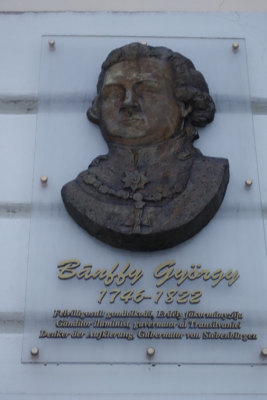
Plaque in Sibiu in memory of György Bánffy (1746-1822), governor of Transylvania under the Habsburgs from 1787 to his death. © R.Belot
What was enlightening, and contributed to a different public perception of heritage in Transylvania, was the equal focus on nature and culture in both cultures, Hungarian and Romanian, contrasting with the divisive nationalism the local identities were accustomed to:
The great thing, it seems to me, about Transylvania, is the combination of natural ecosystems, the forests and the agricultural areas, together with the human, cultural systems; and it is this extraordinary, unique integrated relationship which is of huge importance. Once you pull it all apart, you are left with something that can just be exploited, without being treated in a sustainable way.
The constant support of the Prince of Wales (and the acquisition by him of property in the area) not only triggered a more rational approach of non-urban Hungarian and German heritage in Transylvania – neglected sometimes to the point of destruction by the Romanian state – but it became increasingly attractive in terms of public investment, support and mediatization. This coincided with a time when mansions and castles confiscated by the Communists in 1948, were returned to their rightful owners, successors of the ancient Hungarian nobility, the Catholic Church or Protestant institutions. The National Authority for the Restitution of Property, a governmental agency, managed the restitution. Political scandals, accuses of corruption and biased decision-making were not absent, with nationalist opinions uttered. A total of 57 castles and hundreds of thousands of hectares of forest were claimed, initiating – aside the debate regarding the financial value of the goods and the legality of the process – what seemed to be a new practical comprehension of the economic value of this specific heritage.
This is how the private sector and the civil society, benefiting now from a positive image, started to play a more influential, even decisive role in heritage management in Transylvania.
New Actors: the Private Sector and the Civil Society
The role played by the private sector in the sustainability of the cultural heritage is well established; prestigious NGO federations like Europa Nostra illustrate such a statement. The 2007 international forum on cultural heritage privatization in Catania convened that (1) globalization and government resource pressures would continue to intensify the importance of public/private partnerships; (2) that privatization seems to be efficiently operating; and (3) that private sector solutions should be understood as complementary to governmental intervention rather than antagonistic.
The assumption that only the public sector that can protect and support cultural heritage was (and still is) denied by the realities of heritage properties privately owned now in various counties of Romania. The role of the private sector increased substantially not only in managing all the recovered property – “recovered heritage” – but also in fund-raising, in-kind donations and volunteering to work into heritage preservation or strategy development related to heritage. From this perspective, the situation in Romania is compatible to what Françoise Benhamou described using Mossetto’s distinction between the three levels of heritage preservation (re-use, partial restauration and full preservation): the private market works adequately in the first two cases, while the government regulates the third. Public sector intervention is of course needed to facilitate private sector production, and it occurs in form of legislation, forms of subsidization or defense of private property rights; this is a specifically governmental attribute via specific legislative and judicial means. Nevertheless, when private for-profit demeanor becomes incompatible with the norms that generate cultural benefits for the society, the government has the right to intervene in a regulatory manner by imposing constraints, but not by replacing the private sector. Thirdly, in some cases, the private non-profit sector can get involved as a corrective mechanism, in an educative way, without requiring governmental action except for the usual, indirect assistance of tax facilitation or supple regulatory standards.
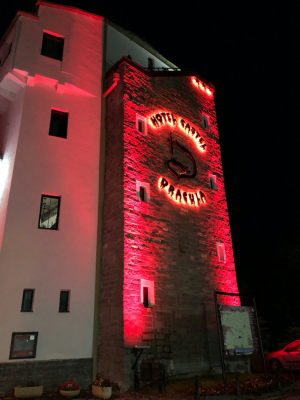
The Dracula Hotel in 2019. © R. Belot
The initial creation of properties valued for their historical and cultural importance was often the product of private sector activity; adding value to heritage or creating new heritage (ranging from investments made by religious groups in building houses of worship revered for their architectural relevance, to corporations whose production facilities became valued as historic industrial sites) is not always emphasized and deserves better consideration. The backing and support of private finance and in-kind donations from individuals and enterprises (crowdfunding included) became a clear method for preserving cultural heritage in Transylvania, and not only. In more recent years, the new corporate paradigm of partnerships was successfully applied in certain cases, but the difference between sponsorship and partnership needs more in order to be better defined.
The motivation for involving the non-profit private sector is to extract fund-raising and volunteer resource potential, and capture at least a part of the contingent valuation that comes with preserving and managing cultural heritage.
The free market approach is directly relevant as it supports the privatization process of the cultural preservation activities, contrasting with the duties of the governmental attributes in the field. Free market and capital are with regard to functions implicit to heritage preservation, such as building and landscape management, marketing, rehabilitation, financing, consolidation (of buildings and land) and economic development. By contrast, governmental attributes – critical even when reliance is on free markets and private property – include the improvement of public areas, of infrastructure, revitalization plans, preservation norms and the preservation of heritage sites prior to private transfer.
When it comes to incentives, the private sector functions remain the same, but direct subsidies and tax incentives are additional public sector tools. In the case of association, akin to the public-private partnership, the primary challenge is that the public sector adds a supplementary task to his role, along with the private, in building rehabilitation, financing, land consolidation and economic development, with the private sector retaining primary responsibility for building management and marketing.
The ever more important role of the private sector (in contrast to ownership and control) was studied by the Council of Europe and acknowledged as “the most interesting area for involving the private sector in protection of the cultural heritage”. Private management can include the management of State property as well as privately owned heritage. Yet, short-term or narrow private interests, financially or commercially oriented, even if at certain points compatible with heritage conservation, can pose a threat to the indispensable long-term and non-commercial calculus needed to determine the optimal distribution of benefits. Specialists like Kevin Gibson emphasized the past efforts to limit conflict between private property shareholders and the stakeholders, arguing that such opposition can be diminished by implementing some fundamental concepts related to heritage assets.
And to close the analysis framework of the heritage management discernable in Transylvania, we can add the interesting categorization of different standards of volunteerism, identified by Edith Archambault: (1) a Rhine model, matching Austria, Belgium, France, Germany and the Netherlands, featuring institutional and professional organizations that operate in various fields, based on particular religions, political affinity or trade union attachments; (2) a Liberal model, specific to the United Kingdom and Ireland, with 19th century Christian socialist roots, generating a sense of social responsibility, but organized locally with little (if any) incentives coming from government, local or regional communities; (3) a Social-Democratic model, typical for the Northern societies, with an associative tradition focusing on individual volunteer interventions, detached from ideological or religious definitions of belongingness; and (4) a Mediterranean model, of Greece, Italy, Portugal and Spain, with a rise of the private sector given the financial limitations of the central authorities, stemming from the tradition of community service of the Catholic Church.
The Transylvanian trends thus join the cultural rights policy promoted by the Council of Europe, designed to contribute to the European identity and protect the distinctive features that build Europe’s rich personality, as cultural identities and their common foundations have to be defended by fostering a deeper comprehension of the cultural qualities of other nations. This might be the wisest path to reconcile two national narratives, the Romanian and the Hungarian, in what is, after all, a shared homeland.
Radu Albu-Comănescu
Bibliography
Heritage for Development in South-East Europe: New Visions and Perceptions of Heritage through the Ljubljana Process, Council of Europe, 2015
Janez Nared, Nika Razpotnik Visković (editors), Managing Cultural Heritage Sites in Southeastern Europe [Enhancement of Cultural Heritage through Environmental Planning and Management], Založba ZRC, 2014
Sanjin Dragojević and Milena Dragićević-Šešić, Arts management in turbulent times: Adaptable quality management, European Cultural Foundation / Boekmanstudies, Amsterdam 2005 (online at https://www.opensocietyfoundations.org/publications/arts-management-turbulent-times-adaptable-quality-management, accessed May 2019)
Corina Şuteu, Overview on Cultural Policy in Central and Eastern Europe 1990/2003, Romanian Academic Society, 2005.
Dan E. Raţiu, “Cultural Policy and Values: Instrinsic versus Instrumental? The Case of Romania’ in: Journal of Arts Management, Law and Society, vol. 39, nº. 1, 2009, pp. 22-44
Interview with the Prince of Wales, https://www.youtube.com/watch?v=7PQJ_kSLt08 (7’50 » to 11’20 », transcript of 8’37 » to 9’10 », accessed June 2019). It was followed by an appraised National Geographic documentary, “Wild Carpathia” (https://www.youtube.com/watch?v=oerXn42bdYs, accessed June 2019).
ICCROM, Privatisation and Cultural Heritage: Proceedings of an International Forum, Urbis, 2007.
Ilde Rizzo, Anna Mignosa, Handbook on the Economics of Cultural Heritage, Edward Elgar Publishing, 2013, p. 112.
Tim Winter, “Heritage diplomacy”, in: International Journal of Heritage Studies, 21, issue 10, 2015, pp. 997-1015.

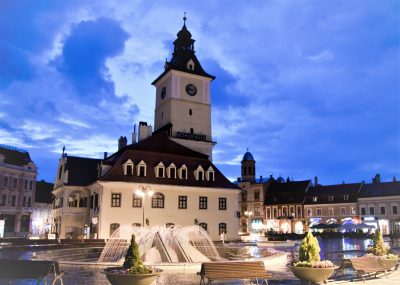
 Université Jean Monnet
Université Jean Monnet